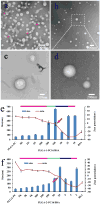Development of multinuclear polymeric nanoparticles as robust protein nanocarriers
- PMID: 24990548
- PMCID: PMC4143165
- DOI: 10.1002/anie.201404766
Development of multinuclear polymeric nanoparticles as robust protein nanocarriers
Abstract
One limitation of current biodegradable polymeric nanoparticles is their inability to effectively encapsulate and sustainably release proteins while maintaining protein bioactivity. Here we report the engineering of PLGA-polycation nanoparticles with a core-shell structure that act as a robust vector for the encapsulation and delivery of proteins and peptides. The optimized nanoparticles can load high amounts of proteins (>20 % of nanoparticles by weight) in aqueous solution without organic solvents through electrostatic interactions by simple mixing, thereby forming nanospheres in seconds with diameters <200 nm. The relationship between nanosphere size, surface charge, PLGA-polycation composition, and protein loading is also investigated. The stable nanosphere complexes contain multiple PLGA-polycation nanoparticles, surrounded by large amounts of protein. This study highlights a novel strategy for the delivery of proteins and other relevant molecules.
Keywords: nanoparticles; polycations; polymers; protein delivery; structure-function relationships.
© 2014 WILEY-VCH Verlag GmbH & Co. KGaA, Weinheim.
Figures





Similar articles
-
Dual drug release from core-shell nanoparticles with distinct release profiles.J Pharm Sci. 2014 Oct;103(10):3205-16. doi: 10.1002/jps.24116. Epub 2014 Aug 12. J Pharm Sci. 2014. PMID: 25116645
-
A robust systematic design: Optimization and preparation of polymeric nanoparticles of PLGA for docetaxel intravenous delivery.Mater Sci Eng C Mater Biol Appl. 2019 Nov;104:109950. doi: 10.1016/j.msec.2019.109950. Epub 2019 Jul 7. Mater Sci Eng C Mater Biol Appl. 2019. PMID: 31499976
-
Dynamics of amphiphilic block copolymers in an aqueous solution: direct imaging of micelle formation and nanoparticle encapsulation.Nanoscale. 2019 Jan 31;11(5):2299-2305. doi: 10.1039/c8nr08922a. Nanoscale. 2019. PMID: 30662983
-
Interfacially formed organized planar inorganic, polymeric and composite nanostructures.Adv Colloid Interface Sci. 2004 Nov 29;111(1-2):79-116. doi: 10.1016/j.cis.2004.07.005. Adv Colloid Interface Sci. 2004. PMID: 15571664 Review.
-
Polymeric nanoparticles and microparticles for the delivery of peptides, biologics, and soluble therapeutics.J Control Release. 2015 Dec 10;219:519-535. doi: 10.1016/j.jconrel.2015.09.001. Epub 2015 Sep 8. J Control Release. 2015. PMID: 26359125 Review.
Cited by
-
Protein-modified nanomaterials: emerging trends in skin wound healing.Discov Nano. 2023 Oct 16;18(1):127. doi: 10.1186/s11671-023-03903-8. Discov Nano. 2023. PMID: 37843732 Free PMC article. Review.
-
Polymeric Nanoparticles Amenable to Simultaneous Installation of Exterior Targeting and Interior Therapeutic Proteins.Angew Chem Int Ed Engl. 2016 Mar 1;55(10):3309-12. doi: 10.1002/anie.201509183. Epub 2016 Feb 5. Angew Chem Int Ed Engl. 2016. PMID: 26846161 Free PMC article.
-
Nanosized Delivery Systems for Therapeutic Proteins: Clinically Validated Technologies and Advanced Development Strategies.Front Bioeng Biotechnol. 2020 Feb 14;8:89. doi: 10.3389/fbioe.2020.00089. eCollection 2020. Front Bioeng Biotechnol. 2020. PMID: 32117952 Free PMC article. Review.
-
Biomaterials for mRNA delivery.Biomater Sci. 2015 Dec;3(12):1519-33. doi: 10.1039/c5bm00198f. Epub 2015 Aug 17. Biomater Sci. 2015. PMID: 26280625 Free PMC article.
-
Silica-Based Nanoparticles for Protein Encapsulation and Delivery.Nanomaterials (Basel). 2018 Nov 1;8(11):886. doi: 10.3390/nano8110886. Nanomaterials (Basel). 2018. PMID: 30388755 Free PMC article.
References
-
- Langer R, Tirrell DA. Nature. 2004;428:487. - PubMed
-
- Gu Z, Biswas A, Zhao M, Tang Y. Chemical Society Reviews. 2011;40:3638. - PubMed
-
- Vermonden T, Censi R, Hennink WE. Chemical Reviews. 2012;112:2853. - PubMed
-
- Yan M, Du J, Gu Z, Liang M, Hu Y, Zhang W, Priceman S, Wu L, Zhou ZH, Liu Z, Segura T, Tang Y, Lu Y. Nat Nano. 2010;5:48. - PubMed
Publication types
MeSH terms
Substances
Grants and funding
LinkOut - more resources
Full Text Sources
Other Literature Sources

